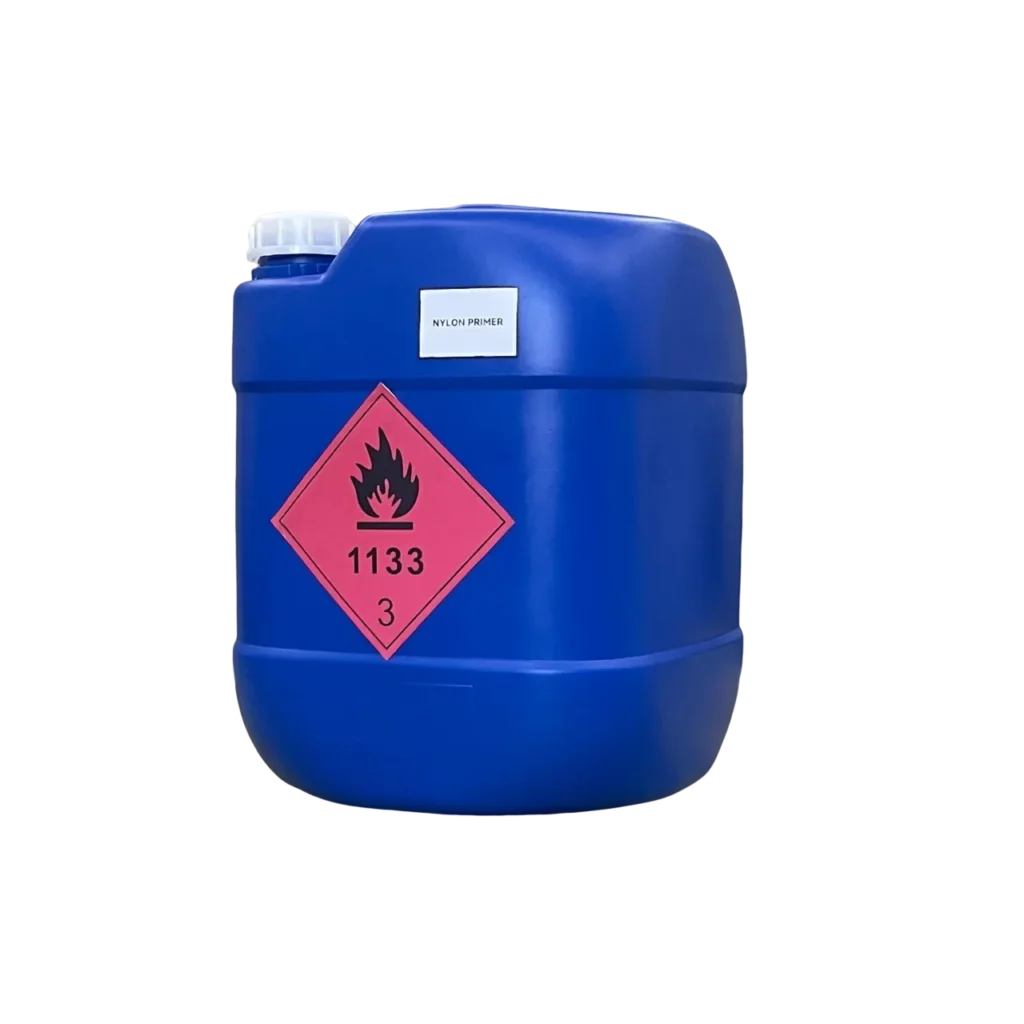
Nylon primer is a specialized solution designed to enhance the adhesion of adhesives to nylon surfaces. Nylon, known for its strength and durability, is often used in footwear components, textiles, and industrial applications. However, due to its smooth, low-energy surface, achieving a strong adhesive bond with nylon can be challenging. A nylon primer works by chemically treating the surface, making it more receptive to adhesives and ensuring a stronger, more reliable bond for various bonding needs, from manufacturing to repair.
Chemical Composition: Typically formulated with solvents and reactive agents that modify the surface properties of nylon, creating better adhesion sites for adhesives like polyurethane, epoxy, or cyanoacrylate.
Drying Time: Dries in approximately 5-15 minutes depending on environmental conditions like temperature and humidity.
Viscosity: Low viscosity, enabling smooth application with brushes or spray systems for even coating.
Temperature Resistance: Effective in temperatures ranging from 10°C to 35°C, making it suitable for most production and repair environments.
Shelf Life: About 12 months when stored properly in a cool, sealed container.
Specific Use Cases: Essential for preparing nylon parts before bonding them with other materials in applications such as footwear components, automotive parts, and industrial assemblies.
Industry Use: Commonly used in the footwear industry for bonding nylon textiles and components, as well as in automotive manufacturing, aerospace, and consumer goods involving nylon parts.
Materials Compatibility: Specifically designed for nylon but can also improve adhesion on other polyamide-based materials, such as nylon blends and some composite materials.
Enhanced Adhesion: Increases bonding strength between nylon surfaces and adhesives, ensuring a secure, durable bond.
Easy Application: Low viscosity allows for simple application with brushes or spray systems, providing uniform coverage.
Quick Drying: Speeds up the bonding process by drying quickly, reducing wait times in production settings.
Consistency: Ensures that the nylon surface is uniformly prepared for adhesion, helping to prevent bonding inconsistencies across different parts.
Long-Lasting Bond: Prepares the surface to create a bond that resists wear, vibration, and environmental stresses, ensuring longevity in both industrial and consumer applications.
Surface Preparation: Clean the nylon surface with a suitable cleaner to remove any oils, dust, or contaminants before applying the primer.
Apply Primer: Use a brush or spray system to apply a thin, even coat of the nylon primer to the bonding area.
Drying Time: Allow the primer to air dry for 5-15 minutes until it is no longer tacky.
Apply Adhesive: Once the primer is dry, apply the adhesive suitable for the specific nylon and other materials being bonded.
Bonding: Press the prepared surfaces together as per the adhesive’s instructions, applying even pressure to ensure a firm bond.
Safety Precautions: Wear gloves, eye protection, and avoid skin contact to prevent irritation. Use in a well-ventilated area to avoid inhaling fumes.
Ventilation Requirements: Ensure good ventilation during application, especially in enclosed spaces, to minimize exposure to vapors.
Disposal Instructions: Dispose of any leftover primer and used applicators according to local regulations; do not pour into drains.
Storage Guidelines: Store in a cool, dry place with the container tightly sealed to prevent evaporation and contamination.
Sustainability Initiatives: Available in low-VOC formulations to minimize impact on indoor air quality and the environment.
Recyclability: Packaged in recyclable containers, making disposal more environmentally friendly.
Non-Toxic Formulas: Some formulations are designed with safer chemicals, making them suitable for use in more sensitive settings.
Problem: Adhesive does not adhere well to the primed nylon surface.
Solution: Ensure that the primer is fully dry before applying the adhesive; insufficient drying time can compromise the bond.
Problem: Primer leaves streaks on the nylon surface.
Solution: Apply a thinner coat of primer and use a clean, high-quality brush or spray for more even distribution.
Problem: Primer dries too quickly in warm conditions.
Solution: Apply in a cooler, controlled environment or use a slower-drying version of the primer to allow for proper application.
Common adhesives in footwear manufacturing include PU adhesives, grafted adhesives, chloroprene adhesives, spray adhesives, and synthetic rubber adhesives, each suited for specific applications.
Choose adhesives based on compatibility with shoe materials, such as leather, fabric, or rubber, considering factors like flexibility and durability. You can also contact our team for more details.
Solvent-based adhesives provide strong bonds and fast drying times, while water-based adhesives are more environmentally friendly and easier to clean.
Adhesive performance can be affected by climate; extreme temperatures or humidity may impact drying times and bond strength.
Safety precautions include working in a well-ventilated area, wearing gloves and masks, and following the manufacturer’s guidelines.
The shelf life of footwear adhesives typically ranges from 6 months to 2 years, depending on storage conditions and formulation.
If you need customized product or technical support, please click the button below. Our expert will come back to you within 24 hours.


